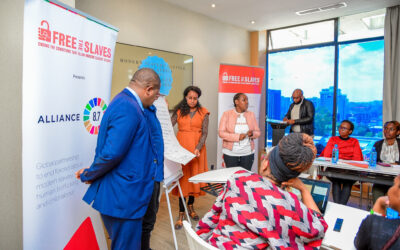It is a great honor for me to become the next chair of the board of directors for Free the Slaves, one of the founding and leading organizations of the global movement against modern slavery.
I am grateful to my dear friend and predecessor, Dan Elkes, whose uncommon generosity and vision have placed us on very strong footing for the future. I look forward to working together with kindred individuals and institutions—within our organization and way beyond it—as Free the Slaves enters its third decade of freedom work.
A generation ago, as I was developing the syllabus for a new course on “protest literature,” I stumbled upon a recently published book, Disposable People: New Slavery in the Global Economy, by scholar-activist Kevin Bales, co-founder of Free the Slaves. As an historian of U.S. social movements whose work at the time focused on 19th century American slavery and abolition, I had never heard of Bales or “modern slavery.” This book shook me to my core. Here I was, a young scholar-activist committed to unearthing the difficult truths of the American past, as well as documenting the social justice movement that sought to remove the stain of slavery from the nation, and I knew nothing of the modern manifestation of this ancient and enduring crime against humanity.
I was so moved by Bales’ groundbreaking work that I invited him to guest lecture in my course, which I’ve taught at Harvard ever since. He accepted my initial invitation and came to Cambridge year after year, dazzling and inspiring my students during each visit. Thus began a longtime friendship, my own fervent commitment to the modern abolitionist movement, and my involvement as a supporter of Free the Slaves.
I first joined the board of Free the Slaves back in 2011, as Kevin and his co-founders—Jolene Smith, Peggy Callahan, and Ginny Baumann—were moving on to other important work. From 2011-2017, I served two terms that included various leadership roles within the organization. Last spring, I agreed to return to the board, and in January, my colleagues unanimously elected me to serve as chair beginning this month. During the past decade, I have helped to guide Free the Slaves through several important moments of transition, and I am thrilled to work closely with my fellow board members and with our trailblazing new Executive Director Bukeni Waruzi and his gifted and growing team as we chart a new path forward.
Free the Slaves was one of the first organizations to sound the alarm about the tens of millions of people enslaved throughout the globe. Slavery has existed in every human society throughout history, and though it looks different across time and space, there are several persistent and pernicious characteristics: the presence of fraud and coercion; the threat and use of violence to perpetuate bondage; the demand for work against one’s will; the exploitation and alienation of the most vulnerable members of society; and the possibility of profit from the ownership and forced labor of people.
Since Free the Slaves was founded two decades ago, global consciousness about modern slavery has risen, and the movement for its abolition has evolved and expanded. The existence of Alliance 8.7, an inclusive global partnership committed to achieving target 8.7 of the 2030 United Nations Sustainable Development Goals, and the ATEST coalition, a U.S.-based coalition committed to ending modern slavery and human trafficking, are just two recent examples of a global antislavery movement that is growing in influence and impact. Free the Slaves is proud to play a continuing leadership role in these vital coalitions.
As we work to build a future free from the scourge of slavery, I think about three areas for creating change: collaboration, coalition, and connection. In terms of collaboration, we need to mobilize and integrate our existing resources—the programmatic models we use for liberation, the measurement methods that help us evaluate our impact, and the financial means we need to develop and implement our work. In terms of coalition, we need to strengthen and sustain existing movement partnerships across countries and contexts, and enlist new stakeholders—in the public and private sectors, at the grassroots and across the globe—to join our global fight for freedom. And in terms of connection, we need to think about antislavery work not as a “niche” issue, but as part of a larger landscape of social justice and human rights efforts that seeks to advance the lives and livelihoods of women and children, migrants and other laborers, persecuted minorities and vulnerable peoples who are either already trapped in slavery or poised precariously on its precipice.
The only way to accomplish all of this is to work together, more intentionally and intensely than ever before. Now is the time. Let us move freedom forward!
Timothy Patrick McCarthy, Ph.D., is an award-winning scholar, educator, activist, and public servant. He holds a joint faculty appointment at Harvard University, where he is Core Faculty at the Kennedy School’s Carr Center for Human Rights Policy. Twittter: @DrTPM. See Dr. McCarthy’s full bio, and those of other FTS board members, here.
Slavery is Always a Crisis: The Past, Present & Future of Freedom Work
Startring in July, Dr. McCarthy will be hosting a series of Zoom conversations with leading figures in the anti-slavery movement – including policymakers, funders, field activists, advocates, artists, corporate stakeholders and survivors. The COVID-19 pandemic is changing the landscape for the anti-slavery movmement. Lean how we must adapt. Join the conversations! Keep an eye on the FTS blog for details.
Editor’s note: Read outgoing FTS Board Chair Daniel Elkes’ reflections in the FTS blog here.



